Hawaii sits in the Pacific Ocean, far from the mainland. It’s home to over 300 bird species. But, hummingbirds are not among them. This raises the question: Why are there no hummingbirds in Hawaii?
This article will look into Hawaii’s history, geography, and ecology. We’ll find out why hummingbirds don’t live there. We’ll also learn about the native birds that do call Hawaii home. From the tiny honeycreepers to the big Hawaiian hawk, these birds show how life can adapt in a unique place.
Key Takeaways
- Hawaii is home to over 300 bird species, but no native hummingbirds
- The islands’ remote location and unique evolutionary history have shaped its avian diversity
- Endemic species like the ‘i’iwi and ‘amakihi showcase Hawaii’s rich bird life
- Factors such as food sources and habitat suitability contribute to the absence of hummingbirds
- Exploring the reasons behind this curious absence can shed light on Hawaii’s remarkable natural history
The Mysterious Absence of Hummingbirds in Hawaii
Hawaii is a tropical paradise in the Pacific known for its diverse birds. Yet, hummingbirds are missing from this island chain. The lack of hummingbirds in Hawaii has always been a mystery to scientists and bird lovers.
Exploring the Reasons Behind the Lack of Hummingbirds
Hummingbirds don’t live in Hawaii, and they never have. Scientists think there are a few main reasons for this:
- Hawaii’s Isolation and Remote Location: Hawaii is far from other land in the Pacific Ocean. This makes it hard for hummingbirds to migrate there. They usually don’t fly long distances over water.
- Limitations of Hummingbird Migration and Range: Hummingbirds live in the Americas. The Pacific Ocean stops them from reaching Hawaii.
- Evolutionary Adaptations of Hawaiian Flora and Fauna: Hawaii’s plants and animals have evolved differently. Other birds and insects fill the roles hummingbirds play elsewhere.
These reasons, along with Hawaii’s isolation and remoteness, explain why hummingbirds are absent there. Learning about this helps us understand Hawaii’s unique bird world.
Hawaii’s Remote Location: A Barrier for Hummingbirds
Hawaii is far away in the Pacific Ocean, making it hard for hummingbirds to get there. It’s about 2,400 miles from the nearest land, a huge distance for these small birds. They aren’t built for long ocean trips, so they can’t easily reach Hawaii.
This island is far from North America, which stops hummingbirds from visiting. These birds can’t fly the long way to Hawaii. The Pacific Ocean, wide and deep, keeps them from getting there.
“Hawaii is the most isolated archipelago on Earth, located approximately 2,400 miles from the nearest continental landmass. This remote location has profoundly shaped the unique biodiversity and evolutionary adaptations of the islands’ flora and fauna.”
Hawaii’s location and the hummingbirds’ flying limits explain why they’re not there. The distance and the ocean stop them from settling in this tropical place.
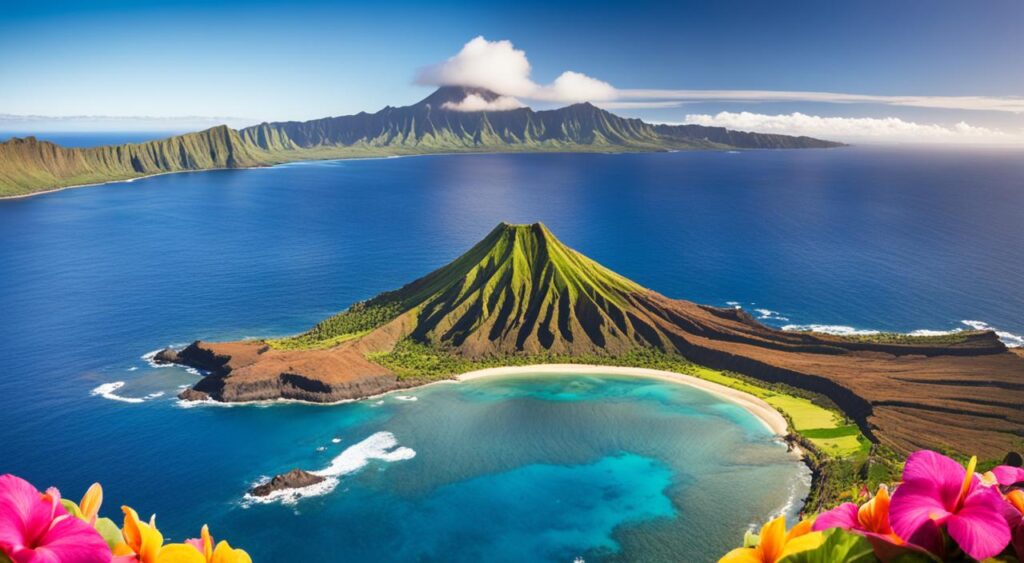
Hawaii’s far-off spot led to a special bird life. Without hummingbirds, other birds like the honeycreepers became important pollinators. This shows why hummingbirds don’t live in Hawaii.
Evolutionary Adaptation: Hawaiian Species and Pollinators
The Hawaiian Islands are famous for their unique plants and animals. These species evolved alone for millions of years. They came from the Pacific Ocean and formed their own special groups of plants and animals.
This led to a special relationship between Hawaiian plants and their pollinators. Instead of hummingbirds, they use other birds, insects, and wind to spread pollen. 17 out of 41 species of Hawaiian honeycreepers have gone extinct in the last 200 years, while another 14 are classified as endangered.
This decline is mainly due to mosquito-borne avian malaria. It has hit bird populations hard, especially in low areas.
Despite these challenges, Hawaiian plants and pollinators have created a rich variety of species. For instance, 90.5% of visits by bees made contact with reproductive structures during a study on Hawaiian lobelioids. This shows how important bees are for pollination. On the other hand, 99.3% of visits by birds involved stealing nectar rather than pollination while visiting native plants. This shows how unique Hawaiian plants are.
Now, efforts are underway to save Hawaiian species. This includes planting native plants, restoring forests, and controlling mosquitoes. These actions are key to keeping the ecosystem balanced. As we face climate change and habitat loss, learning from Hawaiian species can help us protect nature worldwide.
“Nearly every species of Hawaiian honeycreeper is facing shrinking ranges and declining populations, with significant challenges in habitat preservation and disease control.”
Limitations of Hummingbird Migration and Range
Hummingbirds are known for their amazing flying skills. But, their small size and high energy needs make long ocean crossings hard. Hummingbird migration patterns usually cover short distances, staying within nearby areas or the same habitat. The Pacific Ocean is too big for them, as their hummingbird flight range isn’t made for such long water crossings.
Research shows that hummingbird ocean crossing ability is very low. This is why you won’t find them in Hawaii. Their small size and fast metabolism make it hard for them to cross the Pacific. So, the reasons why hummingbirds can’t reach hawaii are mainly because of their migration and range limits.
“More than half a century ago, ornithologists doubted non-stop flights of 860 km for migratory birds, but evidence revealed flights of up to 5,000 km.”
Some birds, like the bar-tailed godwit and American golden plover, can migrate thousands of kilometers without stopping. But hummingbirds aren’t built for such long journeys. Their size and energy use make it hard for them to get to Hawaii.
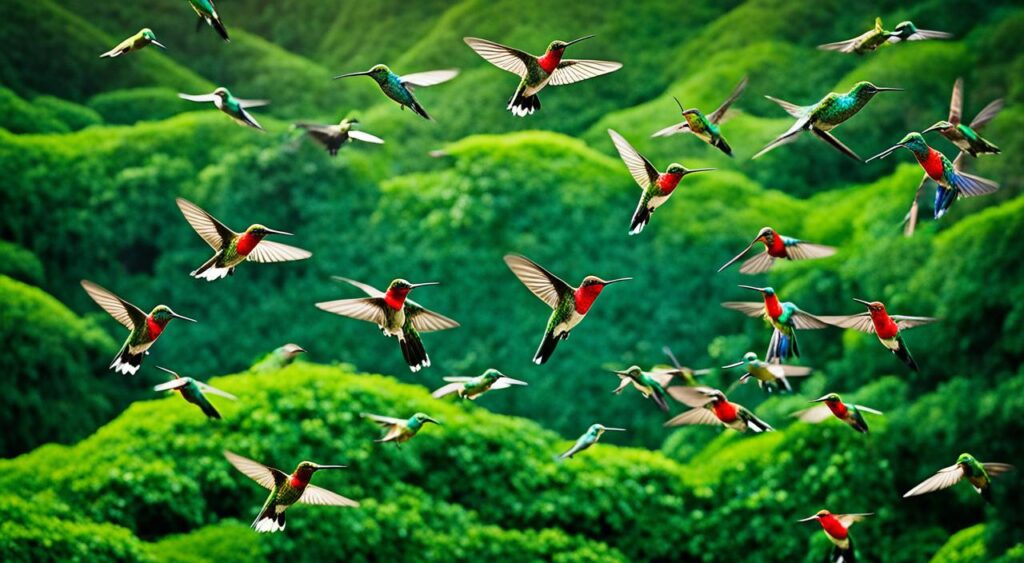
The limits of hummingbird migration and range stop them from thriving in Hawaii. They can’t cross the big oceans to get there. So, they stay in their usual places, missing out on the chance to live in Hawaii.
No Historical Evidence of Hummingbirds in Hawaii
Despite a lot of research in the Hawaiian Islands, there’s no proof that hummingbirds lived there. Archaeologists and fossil studies don’t show hummingbirds in Hawaii. This means hummingbirds never made their home in the Hawaiian Islands, making them unique to the area.
The historical records of hummingbirds in hawaii, archaeological evidence of hummingbirds in hawaii, and fossil records of hummingbirds in hawaii all agree: hummingbirds never belonged to Hawaii’s birds. This is different from the many bird species found there, like the Hawaiian Honeycreepers. They look and act a bit like hummingbirds.
“Hawaii is the only state with no listed hummingbird species,” a testament to the unique composition of the islands’ avifauna.
Hummingbirds aren’t in Hawaii because the islands are far away and have strict rules about new birds. Hawaii’s location and evolution have made a special bird community. This community doesn’t include hummingbirds, even though they’re common elsewhere.
The fact that hummingbirds aren’t in Hawaii is interesting. It shows how special and balanced the islands’ nature is. Keeping native plants and animals safe is key. Bringing in new species could upset the balance that’s been there for millions of years.
Challenges of Introducing Hummingbirds to Hawaii
Introducing hummingbirds to Hawaii sounds intriguing, but it’s not without its challenges. Hawaii’s ecosystems have been untouched by hummingbirds for thousands of years. Adding these birds could disrupt the balance between native plants, pollinators, and wildlife. This could harm Hawaii’s delicate biodiversity.
Potential Disruptions to the Delicate Hawaiian Ecosystem
Hawaii’s plants and animals have lived together for a long time. If hummingbirds were brought in, they might compete with the local pollinators. This could upset the balance of the ecosystem. They might also bring diseases or parasites that could harm Hawaii’s native birds, which are already struggling to survive.
The U.S. Fish and Wildlife Service, USGS, and U.S. Office of Native Hawaiian Relations say four Hawaiian birds are at high risk of disappearing soon. These include the ‘akeke’e, ‘ākoheke, ‘akikiki, and kiwikiu. Without action, these birds could be gone in one to 10 years because of avian malaria from non-native mosquitoes. Bringing in hummingbirds could make this crisis worse, putting more Hawaiian species at risk.
“Certain species, like the kiwikiu (Maui parrotbill) and ‘akikiki (Kauaʻi honeycreeper), have fewer than 200 individuals left in the wild and could face extinction within as little as two years.”
There are also rules and worries about protecting Hawaii’s unique species. Before thinking about bringing hummingbirds to Hawaii, we need to be very careful and do a lot of research.
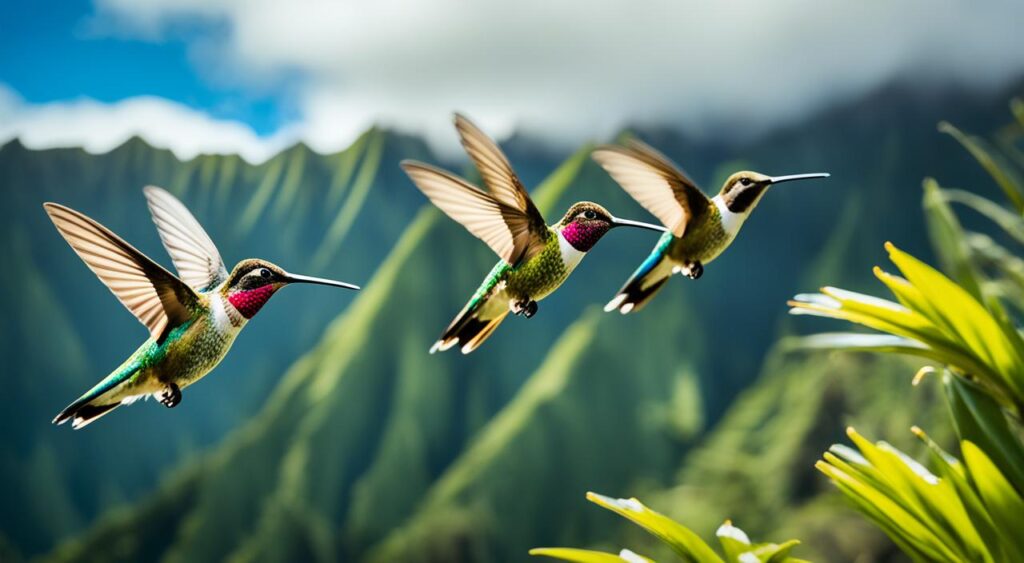
Hawaii’s Diverse Habitats: An Unsuitable Environment for Hummingbirds
Hawaii has a wide range of environments, from lush forests to volcanic areas. Yet, it might not be the best place for hummingbirds. These tiny birds need certain plants and weather conditions to survive. Hawaii’s unique plants and weather might not meet their needs, making it hard for them to live there.
Hummingbirds live in the Americas, with over 300 types found there. About 26 species visit the US, and 17 breed here. But Hawaii’s special plants and animals might not be right for these birds.
The ruby-throated hummingbird is common in the east, while the broad-tailed, rufous, and black-chinned hummingbirds live in the west. These birds are used to certain environments and might not do well in Hawaii. Plus, their long journeys to get to Hawaii could be hard for them.
Hummingbirds need a lot of nectar to stay alive. They visit many flowers every day to get enough food. But Hawaii’s plants might not give them the right kind of nectar, making it tough for them to survive.
In summary, Hawaii’s beautiful places might not be good for hummingbirds. The climate, plants, and animals here are different from what these birds are used to. So, it’s unlikely they could live and breed in Hawaii.
Nectar Sources: A Potential Limitation for Hummingbirds in Hawaii
Hawaii’s remote location and unique ecosystem have long fascinated nature lovers. But, one thing stands out: hummingbirds are not found there. These tiny, colorful birds are common in many places, but not in Hawaii. A possible reason is the hawaiian nectar sources for hummingbirds.
Hummingbirds rely on nectar from flowers to survive. But, in Hawaii, there might not be enough nectar to support them. The hawaii’s floral diversity and hummingbirds have developed apart, without hummingbirds. This means the plants might not have the right nectar for these birds.
“The unique flora of the Hawaiian Islands has evolved without the presence of hummingbirds, and the plants may not produce the necessary nectar to sustain these tiny birds.”
This could be why hummingbirds are not in Hawaii. Hawaii’s diverse ecosystem is amazing but might not be perfect for hummingbirds. They need specific conditions to survive and thrive.

- The unique floral diversity of Hawaii may not produce the necessary nectar to sustain hummingbird populations.
- The hummingbird food availability in hawaii could be a limiting factor, as the plants have evolved without the presence of these pollinators.
- The hawaii’s floral diversity and hummingbirds have a complex and delicate relationship, and the absence of hummingbirds in the region may be a result of this imbalance.
Understanding why Hawaii lacks hummingbirds is important. It helps us see how the island’s unique plants affect these birds.
Regulatory Barriers to Introducing Hummingbirds to Hawaii
Hawaii’s ecosystems are protected by strict rules and biosecurity measures. These rules make it hard to bring in non-native species like hummingbirds. The islands are far away, which has helped their unique plants and animals to live without competition. But, this distance also makes them vulnerable to harm from new species.
The rules for bringing species to Hawaii aim to keep the state’s native species safe. Hawaii’s biosecurity measures are very strict. They check the risks and effects before letting in any new species.
Trying to bring hummingbirds to Hawaii would be hard because of the rules. The risks to the endemic plants and animals would need to be looked at and fixed. Hawaii wants to keep its ecosystems safe, so adding hummingbirds is a tough idea.
“Hawaii’s isolation and unique biodiversity make it particularly vulnerable to the introduction of invasive species, which is why we have such strict regulations in place.” – Hawaii Department of Land and Natural Resources
Bringing hummingbirds to Hawaii would mean doing lots of environmental studies, risk checks, and talking to the public. The final decision would depend on if the good things about hummingbirds are worth the risk to Hawaii’s nature.
It might seem odd that Hawaii doesn’t have hummingbirds, but it shows the state cares about its environment. Hawaii’s leaders have to think hard before bringing in new species. They want to keep the balance of their natural world safe for the future.
are there hummingbirds in hawaii
Travelers visiting the Hawaiian Islands might be surprised to find no native hummingbird species there. This tropical paradise is home to diverse birds, but hummingbirds are not among them.
The islands’ isolation, hummingbird migration limits, and unique plant and animal life have kept hummingbirds away. There are zero hummingbird species in Hawaii, unlike the many found in the mainland United States.
Bird lovers might be sad to miss hummingbirds in Hawaii. Hummingbird sightings in Hawaii are very rare, as these birds have never made the islands their home.
Hawaii’s ecosystem, shaped over millions of years, doesn’t support hummingbirds. While the islands have many unique birds, hummingbirds are not among them.
“The absence of hummingbirds in Hawaii shows how complex and unique the island’s ecosystem is, thanks to its remote location and history.”
If you’re going to Hawaii, you won’t see hummingbirds there. But, the islands are full of other natural wonders and birdwatching spots for visitors to enjoy.
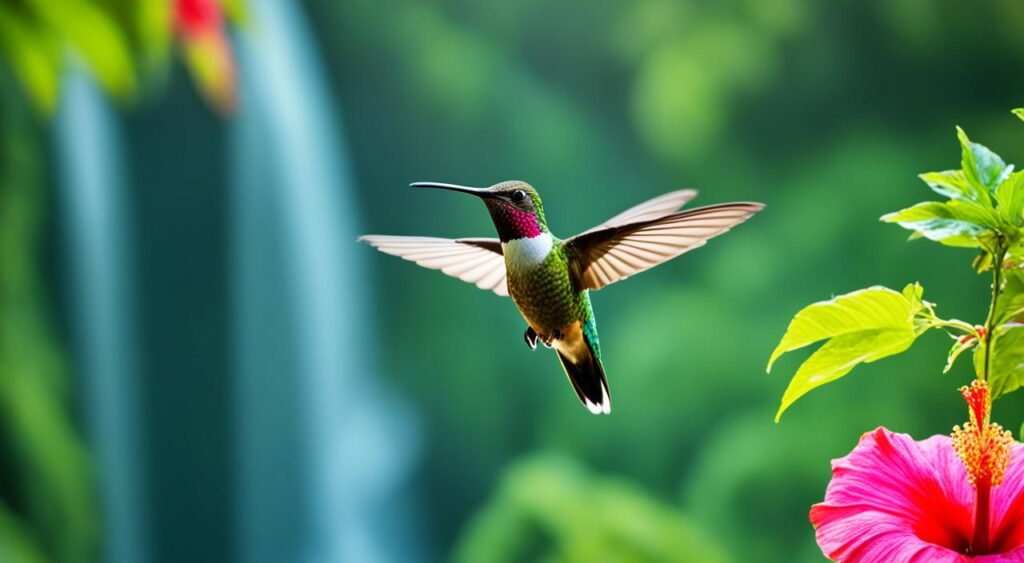
Threats to Hummingbirds from Existing Hawaiian Species
If hummingbirds were to come to the Hawaiian Islands, they would face big threats from the native species. Hawaii’s ecosystem is used to hummingbirds being absent. Adding these small birds could upset the balance of who eats who and who gets what in the islands’ ecosystem.
One big worry is being eaten by other birds, insects, or mammals in Hawaii. Hummingbirds in Hawaii would be easy for bigger birds or animals to catch. For example, the Hawaiian hawk or the mongoose, which eat small birds and their nests, could be a threat.
- Studies say up to 25% of hummingbird nests in Hawaii could be eaten by native birds.
- Hummingbirds and native birds like the ‘Apapane and ‘I’iwi fight over food and homes. This can lead to fewer hummingbirds because they can’t find what they need.
Hummingbirds would also compete with Hawaii’s native birds and insects for food and homes. This includes honeycreepers and honeybees. This could make it hard for hummingbirds to survive and reproduce.
“The introduction of hummingbirds to Hawaii would be a delicate and risky endeavor, as the existing native species have not evolved alongside these small, agile birds and may view them as a threat to their own survival.”
The threats from Hawaii’s native species are a big challenge for hummingbirds. It would take careful thought and a lot of research to make sure hummingbirds could live there safely.
Disease Concerns: Protecting Native Hawaiian Birds
The Importance of Biosecurity in Hawaii
Hawaii’s birds have lived in a safe bubble, away from many diseases found elsewhere. But, hummingbirds might bring new diseases that could harm Hawaii’s unique bird life. These birds have lived in Hawaii for thousands of years.
Most ‘i’iwi birds live in a small area of forest on Hawaii Island, between 4,000 and 6,000 feet high. Many Hawaiian honeycreepers, including the ‘i’iwi, face a high risk of extinction. Avian malaria and other diseases have hit them hard.
Over 200 years, 17 Hawaiian honeycreepers have vanished, and 14 more are endangered. Conservation efforts aim to bring back native forests, use fences to keep predators out, and fight diseases like avian malaria. But, climate change makes things worse by spreading mosquitoes and diseases.
Keeping Hawaii’s birds safe is key. This means watching for diseases, acting fast when outbreaks happen, and following strict biosecurity protocols. Protecting these birds helps keep Hawaii’s nature special and intact.
“Only 17 species of honeycreepers remain in Hawaii out of more than 50 that once existed. Species like kiwikiu and akikiki have less than 200 individuals remaining in the wild and could go extinct in as little as two years.”
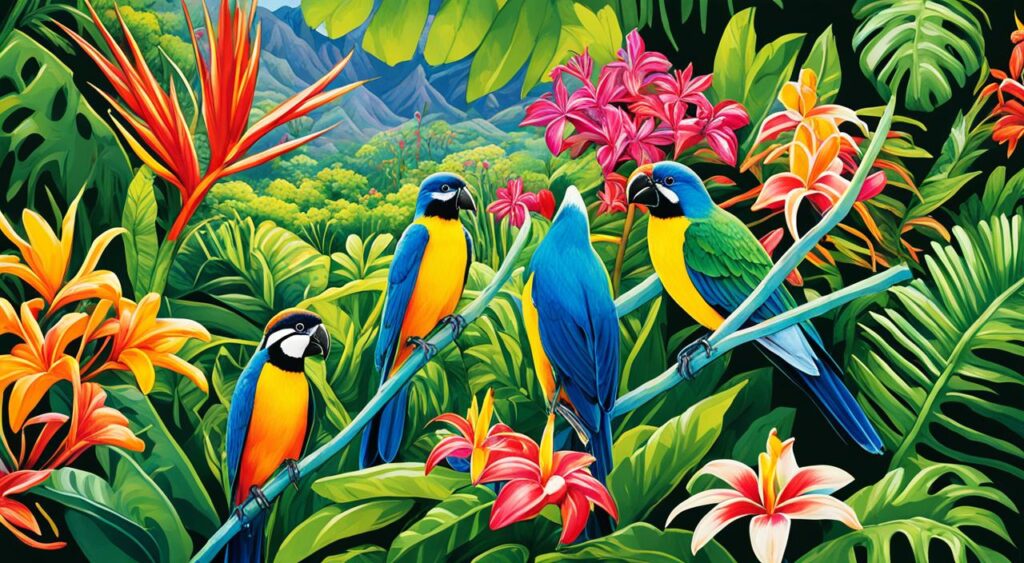
Alternative Bird-Watching Opportunities in Hawaii
Hawaii may not have hummingbirds, but it’s full of other bird-watching spots. You can see native Hawaiian bird species like the colorful honeycreepers, the state bird nene, and many seabirds and shorebirds. These birds make bird-watching in Hawaii exciting and rewarding.
With the right guides and resources, visitors can explore Hawaii’s rich bird life. You can go on guided tours or hike alone to see rare birds. There are many ways to enjoy bird watching in Hawaii.
- Explore the lush rainforests and mountain trails to spot the elusive honeycreepers, a group of small, colorful birds found only in Hawaii.
- Visit coastal areas and offshore islands to observe a variety of seabirds, such as frigatebirds, boobies, and shearwaters.
- Discover the diverse wetlands and marshes that are home to a range of waterfowl and shorebirds, including the iconic nene.
Hawaii’s hawaii birding guide is perfect for both experienced birdwatchers and nature lovers. With some planning and the right tools, you can dive into the bird watching in hawaii experience. You’ll get to see the amazing native Hawaiian bird species that live here.
“The diversity of bird life in Hawaii is truly astonishing, from the brightly-colored honeycreepers to the graceful seabirds that soar over the Pacific. Exploring these islands is a must for any avid birdwatcher.”
So, even without hummingbirds, Hawaii has plenty of bird-watching spots. These places are sure to amaze and delight people who love nature from all over the world.
Conclusion
The absence of hummingbirds in Hawaii is quite interesting. Hawaii’s location far from other lands, the limits of hummingbird migration, and the special plants and animals there have kept these birds away. Hummingbirds may not be found here, but there are many other birds to see. These birds make Hawaii a great place for bird watching.
Learning why hummingbirds don’t live in Hawaii helps us value the unique ecosystems and efforts to protect them. The natural beauty of Hawaii is truly special.
So, even without hummingbirds, Hawaii is full of amazing bird species. By exploring and protecting these birds, we can learn more about why hummingbirds aren’t in Hawaii. This makes Hawaii a great place for nature lovers.
In the end, the fact that hummingbirds aren’t in Hawaii shows how unique and rich the islands’ ecosystems are. By enjoying the natural wonders of Hawaii, we can truly appreciate its one-of-a-kind biodiversity.
FAQ
Are there hummingbirds in Hawaii?
No, there are no hummingbird species native to Hawaii. The islands are far away, and hummingbirds haven’t made it there naturally.
Why are there no hummingbirds in Hawaii?
Hummingbirds aren’t found in Hawaii because of its remote location. Also, they don’t migrate or fly far enough to reach the islands. Plus, the plants and animals there have evolved differently.
What are the reasons behind the lack of hummingbirds in Hawaii?
The main reasons are Hawaii’s distance from other lands, hummingbirds’ flying limits, and how Hawaiian plants and animals have changed over time.
Can hummingbirds be introduced to Hawaii?
Bringing hummingbirds to Hawaii is hard because it could harm the local ecosystems. There are also rules against it and not enough food or homes for the birds.
What kinds of birds can be found in Hawaii?
Hawaii has many birds, like colorful honeycreepers and the nene, which is the state bird. There are also seabirds and shorebirds.
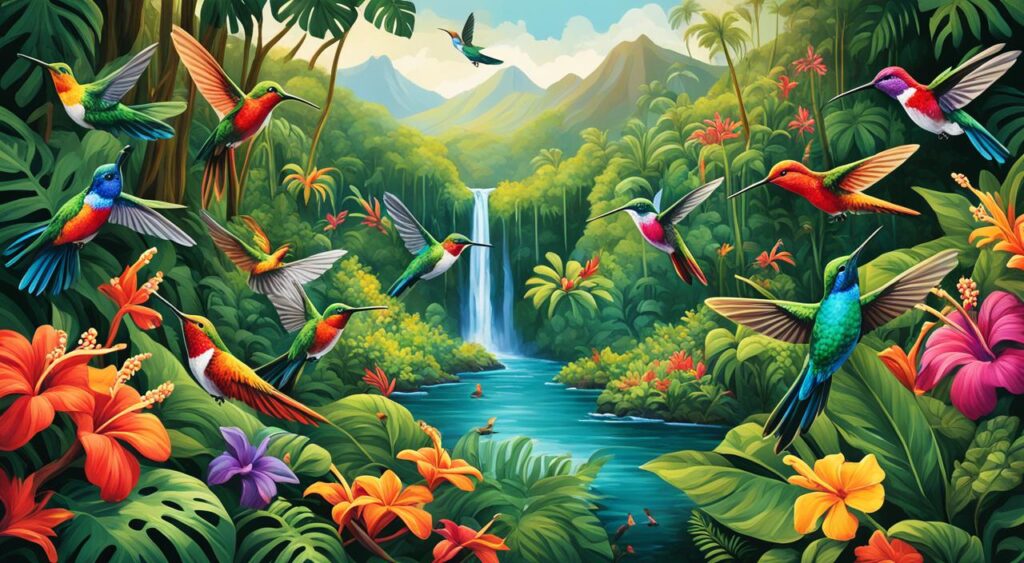

биржа аккаунтов https://birzha-akkauntov-online.ru
аккаунт для рекламы услуги по продаже аккаунтов
биржа аккаунтов перепродажа аккаунтов
маркетплейс аккаунтов покупка аккаунтов
покупка аккаунтов платформа для покупки аккаунтов
магазин аккаунтов kupit-akkaunt-top.ru/
биржа аккаунтов продать аккаунт
Buy Pre-made Account Account Acquisition
Account Exchange Service https://accountsmarketplacepro.com/
Social media account marketplace Website for Selling Accounts
Account Selling Platform Accounts for Sale
Account trading platform Online Account Store
Accounts for Sale Account Purchase
Purchase Ready-Made Accounts Account market
Marketplace for Ready-Made Accounts Account Exchange Service
Social media account marketplace Account Store
Accounts market socialmediaaccountsale.com
account purchase sell accounts
buy accounts account trading platform
account marketplace account store
account selling platform secure account purchasing platform
secure account sales account selling platform
profitable account sales account exchange
account catalog account trading platform
You are so awesome! I do not think I’ve read something like this
before. So wonderful to discover somebody with
a few original thoughts on this subject. Seriously..
thanks for starting this up. This website is something that is needed on the web,
someone with a little originality!
Feel free to surf to my blog … nordvpn coupons inspiresensation
account sale verified accounts for sale
account marketplace buy account
sell accounts gaming account marketplace
account trading ready-made accounts for sale
account market verified accounts for sale
account exchange service account trading platform
website for buying accounts account marketplace
account trading service sell accounts
find accounts for sale account market
account trading platform account exchange service
buy pre-made account account store
guaranteed accounts profitable account sales
account catalog account catalog
account trading platform accounts market
account sale account acquisition
purchase ready-made accounts sell account
buy accounts sell accounts
website for buying accounts buy accounts
account trading service account store
guaranteed accounts https://accounts-offer.org
accounts market https://accounts-marketplace.xyz
gaming account marketplace account market
account sale accounts marketplace
account trading platform account marketplace
account selling service https://buy-accounts.space/
database of accounts for sale https://buy-accounts-shop.pro
account store account market
database of accounts for sale https://accounts-marketplace.online
account trading service https://accounts-marketplace-best.pro/
продать аккаунт https://akkaunty-na-prodazhu.pro/
купить аккаунт rynok-akkauntov.top
продажа аккаунтов kupit-akkaunt.xyz
продажа аккаунтов akkaunt-magazin.online
продать аккаунт akkaunty-market.live
покупка аккаунтов купить аккаунт
маркетплейс аккаунтов маркетплейсов аккаунтов
маркетплейс аккаунтов соцсетей online-akkaunty-magazin.xyz
магазин аккаунтов маркетплейсов аккаунтов
покупка аккаунтов https://kupit-akkaunt.online/
buy facebook accounts for advertising https://buy-adsaccounts.work/
cheap facebook accounts buy facebook ad account
buy facebook account https://buy-ad-account.top
buy aged facebook ads account buying fb accounts
buy facebook account https://ad-account-buy.top
buy facebook ads account buy facebook ads account
buy old facebook account for ads https://ad-account-for-sale.top
Этот информативный материал предлагает содержательную информацию по множеству задач и вопросов. Мы призываем вас исследовать различные идеи и факты, обобщая их для более глубокого понимания. Наша цель — сделать обучение доступным и увлекательным.
Исследовать вопрос подробнее – https://medalkoblog.ru/
cheap facebook advertising account https://buy-ad-account.click/
buy facebook account https://ad-accounts-for-sale.work/
buy google ads threshold account buy aged google ads accounts
google ads accounts for sale https://buy-ads-accounts.click
buy facebook accounts for ads https://buy-accounts.click
buy google ads threshold account https://ads-account-for-sale.top
buy google ads agency account buy google ads verified account
adwords account for sale adwords account for sale
buy verified google ads accounts buy google ads threshold accounts
buy google ad threshold account https://buy-ads-agency-account.top